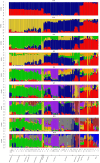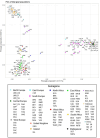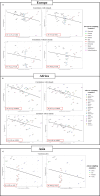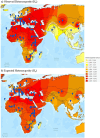Investigating the footprint of post-domestication dispersal on the diversity of modern European, African and Asian goats
- PMID: 39068382
- PMCID: PMC11282621
- DOI: 10.1186/s12711-024-00923-5
Investigating the footprint of post-domestication dispersal on the diversity of modern European, African and Asian goats
Abstract
Background: Goats were domesticated in the Fertile Crescent about 10,000 years before present (YBP) and subsequently spread across Eurasia and Africa. This dispersal is expected to generate a gradient of declining genetic diversity with increasing distance from the areas of early livestock management. Previous studies have reported the existence of such genetic cline in European goat populations, but they were based on a limited number of microsatellite markers. Here, we have analyzed data generated by the AdaptMap project and other studies. More specifically, we have used the geographic coordinates and estimates of the observed (Ho) and expected (He) heterozygosities of 1077 European, 1187 African and 617 Asian goats belonging to 38, 43 and 22 different breeds, respectively, to find out whether genetic diversity and distance to Ganj Dareh, a Neolithic settlement in western Iran for which evidence of an early management of domestic goats has been obtained, are significantly correlated.
Results: Principal component and ADMIXTURE analyses revealed an incomplete regional differentiation of European breeds, but two genetic clusters representing Northern Europe and the British-Irish Isles were remarkably differentiated from the remaining European populations. In African breeds, we observed five main clusters: (1) North Africa, (2) West Africa, (3) East Africa, (4) South Africa, and (5) Madagascar. Regarding Asian breeds, three well differentiated West Asian, South Asian and East Asian groups were observed. For European and Asian goats, no strong evidence of significant correlations between Ho and He and distance to Ganj Dareh was found. In contrast, in African breeds we detected a significant gradient of diversity, which decreased with distance to Ganj Dareh.
Conclusions: The detection of a genetic cline associated with distance to the Ganj Dareh in African but not in European or Asian goat breeds might reflect differences in the post-domestication dispersal process and subsequent migratory movements associated with the management of caprine populations from these three continents.
© 2024. The Author(s).
Conflict of interest statement
The authors declare that they have no competing interests.
Figures





References
-
- Porter V, Alderson L, Hall SJG, Sponenberg DP. Goats. In: Porter V, Alderson L, Hall S, Sponenberg P, editors. Mason’s world encyclopedia of livestock breeds and breeding. Wallingford: CABI; 2016. p. 350–2.
MeSH terms
Grants and funding
LinkOut - more resources
Full Text Sources

